|
In Commemoration of the Second Anniversary of the Great East Japan Earthquake: “Japanese Week” (No.11)
March 13, 2013
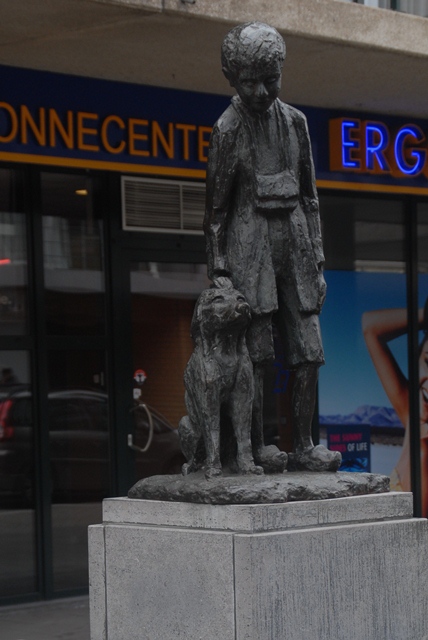 “A Dog of Flanders” published by the English female writer, Ouida, (real name Marie Louise de la Ramée) in 1872 has been translated and introduced in Japan several times since the beginning of the 20th century as one of the representative children’s books. The heartrending story of Nello and Patrasche has moved many Japanese boys and girls to tears. However, not many people in Flanders, where the book is set, know this work and it seems to have a poor reputation. The fact that this book is, on the contrary, extremely popular and widely read in Japan is so surprising that even a documentary movie (2007) was made to unravel the mystery. This book has been published in the United States as well and it has even been turned into a movie several times, but the tragic ending of the story has been changed into a happy one. Yet it becomes even more complicated because in the American movie released in Japan the ending was changed again to the original one in which Nello and his beloved dog Patrasche die at the end. According to the conclusion in the documentary movie mentioned above, this story that projects in European eyes only “the death of a losing dog” resonates well with “the aesthetics of ruin” embedded in the Japanese heart and that’s why the Japanese are so touched by it (this theory was also introduced in Shiba Ryotaro’s “Travel Piece in Holland” of “Going on Main Roads series”). However, the Japanese animated TV series adaptation of “A Dog of Flanders” was aired on national television in the Netherlands and became a popular program reaching 80% viewers. The appeal of Japanese Anime seems to be universal. The other day, I visited Hoboken, the setting of the story, on the outskirts of Antwerp and saw the statue of Nello and Patrasche, but also this statue was built for Japanese tourists in 1986 and there is even a monument (2003) donated by Toyota in front of the Notre-Dame Cathedral. Well, well, what would the original author Ms Ouida think in the hereafter about her own work after 100 years? “A Dog of Flanders” published by the English female writer, Ouida, (real name Marie Louise de la Ramée) in 1872 has been translated and introduced in Japan several times since the beginning of the 20th century as one of the representative children’s books. The heartrending story of Nello and Patrasche has moved many Japanese boys and girls to tears. However, not many people in Flanders, where the book is set, know this work and it seems to have a poor reputation. The fact that this book is, on the contrary, extremely popular and widely read in Japan is so surprising that even a documentary movie (2007) was made to unravel the mystery. This book has been published in the United States as well and it has even been turned into a movie several times, but the tragic ending of the story has been changed into a happy one. Yet it becomes even more complicated because in the American movie released in Japan the ending was changed again to the original one in which Nello and his beloved dog Patrasche die at the end. According to the conclusion in the documentary movie mentioned above, this story that projects in European eyes only “the death of a losing dog” resonates well with “the aesthetics of ruin” embedded in the Japanese heart and that’s why the Japanese are so touched by it (this theory was also introduced in Shiba Ryotaro’s “Travel Piece in Holland” of “Going on Main Roads series”). However, the Japanese animated TV series adaptation of “A Dog of Flanders” was aired on national television in the Netherlands and became a popular program reaching 80% viewers. The appeal of Japanese Anime seems to be universal. The other day, I visited Hoboken, the setting of the story, on the outskirts of Antwerp and saw the statue of Nello and Patrasche, but also this statue was built for Japanese tourists in 1986 and there is even a monument (2003) donated by Toyota in front of the Notre-Dame Cathedral. Well, well, what would the original author Ms Ouida think in the hereafter about her own work after 100 years?
< Japanese Week Held in Brussels >
March 11th, the second year after the Great East Japan earthquake. The Embassy of Japan and the Japanese Mission to the EU held a memorial event called “Japanese Week in Brussels 2013”and on the first day, the 11th, a “Japanese Cultural Evening” was held at the Palais des Beaux-Arts. Despite the bad weather with light snow, about 300 people from various circles in Belgium, from diplomatic missions and from Nihonjinkai attended, which made it a successful event. In my speech after I had asked one minute of silence, I reported that although the earthquake and the nuclear accident made many victims and that although even now more than 300.000 people are forced to live in evacuation, the Japanese government and local people are united and make the utmost efforts for rehabilitation and reconstruction. In addition, I thanked again the people of Belgium who donated more than 180 thousands euro to Japan for victim relief. As an introduction to Japanese culture, we had demonstrations of the tea ceremony and Ikebana, and performances of Japanese drums and Koto. I hope that the “thoughts of remembrance” of this day on which we all gathered in Brussels will reach Japan.
< 6th Company Visit: Two Japanese Companies >
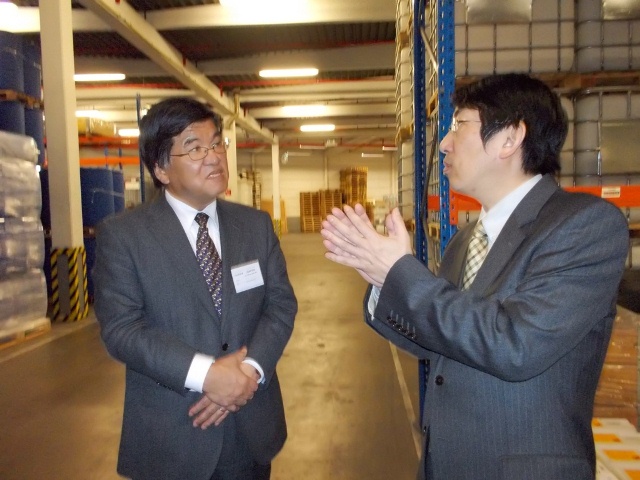 A week ago, I visited FUJIFILM BELGIUM in Sint-Niklaas (50 km northwest from Brussels, 72.000 inhabitants). This company began the production of chemicals for photographic and graphic arts and pre-press and pressroom chemicals in 1984, so next year is the 30 year anniversary. Though the current number of employees is 160, the factory is unusual in the sense that most of them are white collar workers. In addition to their own goods, FUJIFILM BELGIUM also started manufacturing products of other companies by contracts from 2010 on. Since last year the company sells products of FUJIFILM’s headquarters as well. Technology advances rapidly in the world of pictures and printing. Due to the popularity of the digital camera, the number of people that do not need photo film anymore or do not print their photos at all has increased, thus changing the product demand. Moreover, a new situation is emerging: if taking pictures with one’s mobile phone with camera becomes common, the demand itself will decrease greatly. While rival companies withdraw from the market, FUJIFILM BELGIUM expanded its products’ market share, but since the demand decreases even further, it seems a difficult management. It might be necessary to consider the possibility of a diversified business development, including in the chemical business and in the field of medical and pharmaceutical products.
A week ago, I visited FUJIFILM BELGIUM in Sint-Niklaas (50 km northwest from Brussels, 72.000 inhabitants). This company began the production of chemicals for photographic and graphic arts and pre-press and pressroom chemicals in 1984, so next year is the 30 year anniversary. Though the current number of employees is 160, the factory is unusual in the sense that most of them are white collar workers. In addition to their own goods, FUJIFILM BELGIUM also started manufacturing products of other companies by contracts from 2010 on. Since last year the company sells products of FUJIFILM’s headquarters as well. Technology advances rapidly in the world of pictures and printing. Due to the popularity of the digital camera, the number of people that do not need photo film anymore or do not print their photos at all has increased, thus changing the product demand. Moreover, a new situation is emerging: if taking pictures with one’s mobile phone with camera becomes common, the demand itself will decrease greatly. While rival companies withdraw from the market, FUJIFILM BELGIUM expanded its products’ market share, but since the demand decreases even further, it seems a difficult management. It might be necessary to consider the possibility of a diversified business development, including in the chemical business and in the field of medical and pharmaceutical products.
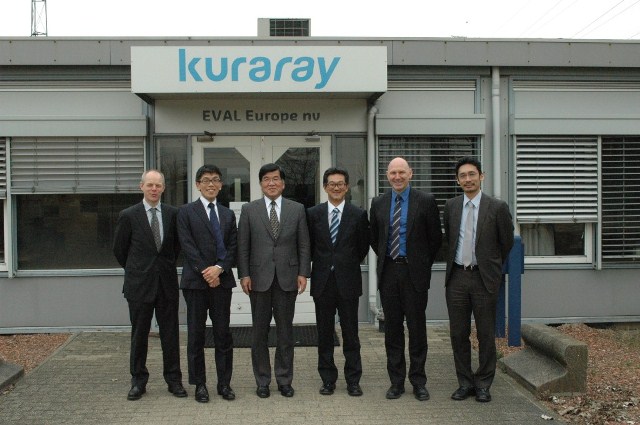 The next day, I visited EVAL Europe (affiliated with Kuraray) in Antwerp and observed the production process of a copolymer called EVOH (Ethylene vinyl alcohol: transparent globular particles with a diameter of 2-3mm) which is one of the materials in plastic film used for food packaging. Plastic film is usually a 50-100 micron thick ultrathin multilayer structure and EVOH is used for the 5 micron thick middle layer. As no big rival companies make this product, this product has the largest market share in the world. This company was founded in 1997 in a corner of a vast site owned by the Swiss petrochemical company INEOS. The current number of employees is 107, including 5 Japanese. And yet, the small number is surprising because the sales market extends to the Middle East, in addition to the entire Europe including Russia. Antwerp is the world’s second largest cluster of petrochemical industry after Houston in the US, and at the same time, the corporate strategy to make the most of the economic and social infrastructure in Belgium, which is the most globalized country in the world, seems to be highly successful. The next day, I visited EVAL Europe (affiliated with Kuraray) in Antwerp and observed the production process of a copolymer called EVOH (Ethylene vinyl alcohol: transparent globular particles with a diameter of 2-3mm) which is one of the materials in plastic film used for food packaging. Plastic film is usually a 50-100 micron thick ultrathin multilayer structure and EVOH is used for the 5 micron thick middle layer. As no big rival companies make this product, this product has the largest market share in the world. This company was founded in 1997 in a corner of a vast site owned by the Swiss petrochemical company INEOS. The current number of employees is 107, including 5 Japanese. And yet, the small number is surprising because the sales market extends to the Middle East, in addition to the entire Europe including Russia. Antwerp is the world’s second largest cluster of petrochemical industry after Houston in the US, and at the same time, the corporate strategy to make the most of the economic and social infrastructure in Belgium, which is the most globalized country in the world, seems to be highly successful.
< GC Europe’s Ceremony >
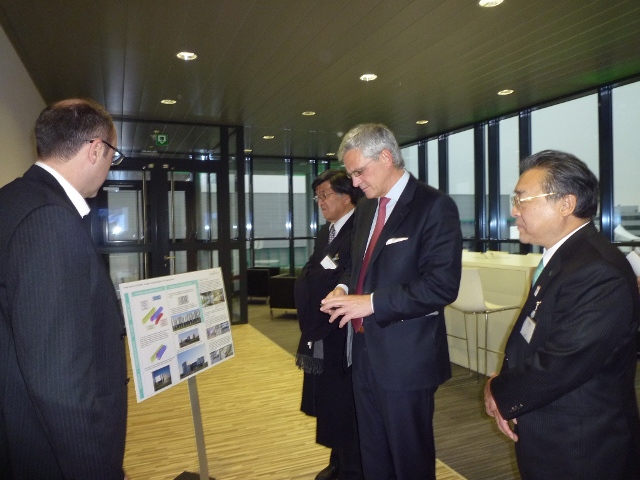 The other day, I attended as one of the guests the opening ceremony of GC Europe’s office building in Leuven. GC Company has a company history of more than 90 years as a manufacturer of dental materials and related equipment. GC Europe started its activities in Belgium in 1972 and is producing its own products in a factory in Leuven since 1989. The number of employees is 292 in total (they call each other “associate”), of which 100 employees are working in Belgium. President Mr Makoto NAKAO attended this ceremony from Japan and on the Belgian side were present Kris Peeters, Minister-President of Flanders and Louis Tobback, mayor of Leuven. The interior design of the new office building is based around the colour white and glass. The partitions as well are devised to facilitate communication between employees. I look forward to the further development of this company. The other day, I attended as one of the guests the opening ceremony of GC Europe’s office building in Leuven. GC Company has a company history of more than 90 years as a manufacturer of dental materials and related equipment. GC Europe started its activities in Belgium in 1972 and is producing its own products in a factory in Leuven since 1989. The number of employees is 292 in total (they call each other “associate”), of which 100 employees are working in Belgium. President Mr Makoto NAKAO attended this ceremony from Japan and on the Belgian side were present Kris Peeters, Minister-President of Flanders and Louis Tobback, mayor of Leuven. The interior design of the new office building is based around the colour white and glass. The partitions as well are devised to facilitate communication between employees. I look forward to the further development of this company.
< The Committee of Foreign Affairs of the Belgian Chamber of Representatives >
Last week, I had the opportunity to have a meeting with prominent members of the Committee of Foreign Affairs of the Belgian Chamber of Representatives, including the Chairman Mr François-Xavier de DONNEA and two vice-chairmen. Chairman DE DONNEA’s political career spans over 40 years, but Mr Herman DE CROO (former president of the Chamber of Representatives), who attended the meeting as well, has an even longer political career and is the oldest of all members of the federal parliament. Even though he did not look that old, I was a little surprised that his son serves as Deputy Prime Minister in the federal government. I explained in detail the reconstruction of Japan and Japan’s nuclear policy after the nuclear accident in Fukushima. All Members of Parliament were strongly interested in the economic and financial policy called “Abenomics” named after the new Prime Minister Abe. We also talked about the outlook of the Economic Partnership Agreement negotiations between Japan and the EU. Late at night when the meeting had finished, I was surprised to hear that certain politicians had to drive more than 100km to their home. In Japan, most regionally elected parliamentarians stay on weekdays at the lodging house for parliamentarians in Tokyo. In Belgium, however, since it is a little country, it is normal that the Members of Parliament do not stay in Brussels, but go home after work. I realized once again that the living circumstances of parliamentarians differ from country to country.
< The Carnival of La Louvière >
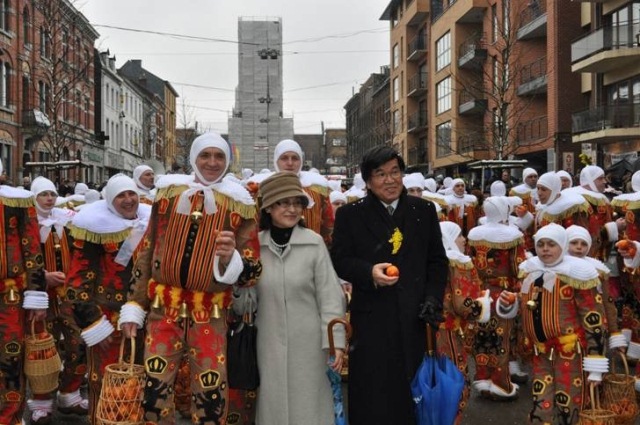 Last Sunday, I received an invitation from M. Olivier DESTREBECQ, member of the Chamber of Representatives and echevin in La Louvière, for the local carnival. I enjoyed the 135 year old “Laetare festival” while light snow was falling. As introduced in Ambassador’s Chat No. 7, La Louvière is a city of 80.000 inhabitants, 60 km south of Brussels and the fourth largest city in Wallonia. Late 19th century, this town was also known for mining and apparently the miners started the Laetare festival to have fun in between the hard work (the carnival of La Louvière rivalled with the famous carnival of Binche, south of La Louvière). The carnival is held 3 weeks before Easter over 3 days and I only saw part of the first day. Young people from 11 neighbourhood associations compete against each other for the best carnival costume and parade through the city, mixed with groups made up of local residents in disguise. One of the spectacles is a large group of 800-900 young people called “Gilles” in colourful dress handing out (throwing) oranges from a basket while parading through the town. What characterizes this carnival are the masqueraded groups wearing skin-coloured masks (with a red moustache and beard and green sunglasses) on white clothes, but I was not able to see them during the time I visited the carnival. I was able to greet the mayor Mr Jacques GOBERT on the square in front of the city hall. Anyway, despite the bad weather, it was such a great turnout that one could hardly move. Struggling to avoid the flying oranges, I regret a little that I was not able to enjoy fully the carnival. Last Sunday, I received an invitation from M. Olivier DESTREBECQ, member of the Chamber of Representatives and echevin in La Louvière, for the local carnival. I enjoyed the 135 year old “Laetare festival” while light snow was falling. As introduced in Ambassador’s Chat No. 7, La Louvière is a city of 80.000 inhabitants, 60 km south of Brussels and the fourth largest city in Wallonia. Late 19th century, this town was also known for mining and apparently the miners started the Laetare festival to have fun in between the hard work (the carnival of La Louvière rivalled with the famous carnival of Binche, south of La Louvière). The carnival is held 3 weeks before Easter over 3 days and I only saw part of the first day. Young people from 11 neighbourhood associations compete against each other for the best carnival costume and parade through the city, mixed with groups made up of local residents in disguise. One of the spectacles is a large group of 800-900 young people called “Gilles” in colourful dress handing out (throwing) oranges from a basket while parading through the town. What characterizes this carnival are the masqueraded groups wearing skin-coloured masks (with a red moustache and beard and green sunglasses) on white clothes, but I was not able to see them during the time I visited the carnival. I was able to greet the mayor Mr Jacques GOBERT on the square in front of the city hall. Anyway, despite the bad weather, it was such a great turnout that one could hardly move. Struggling to avoid the flying oranges, I regret a little that I was not able to enjoy fully the carnival.
|

